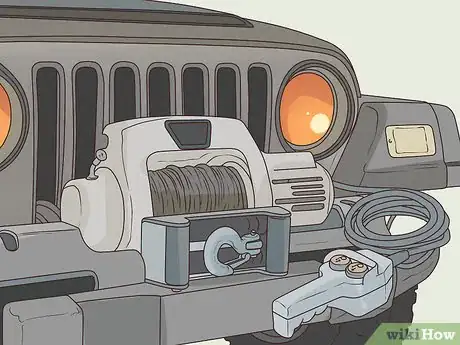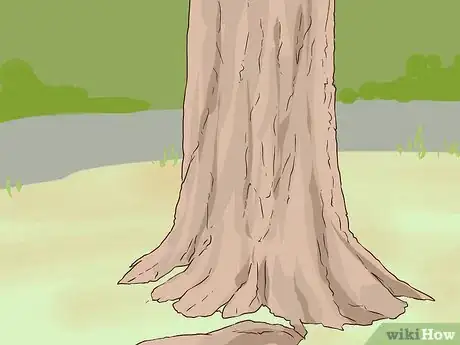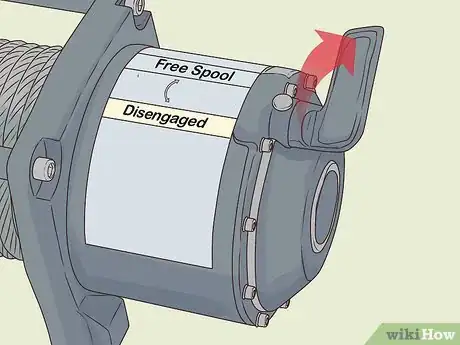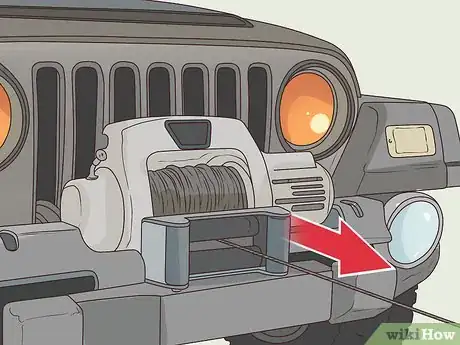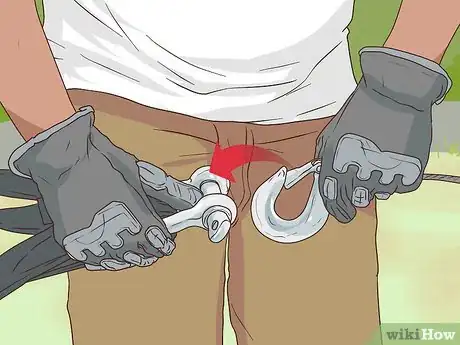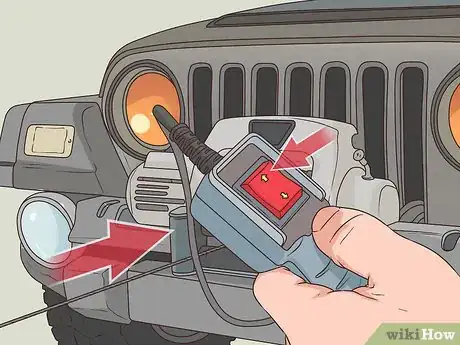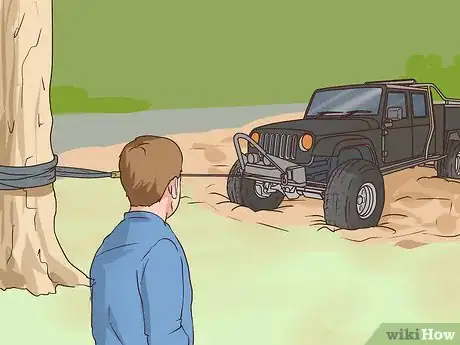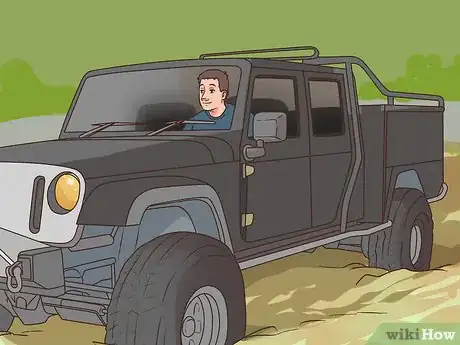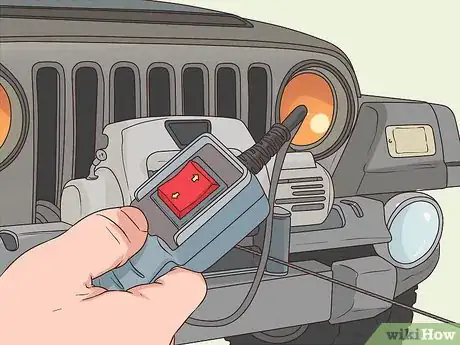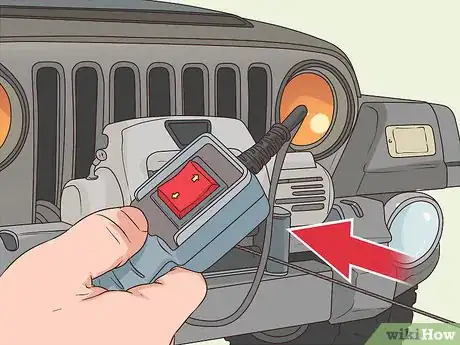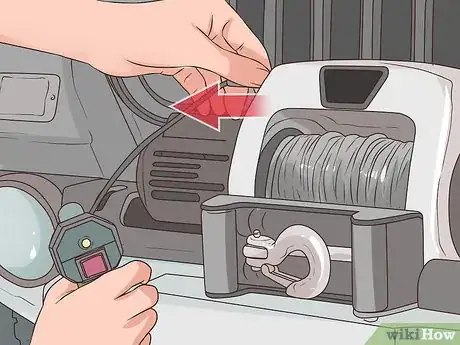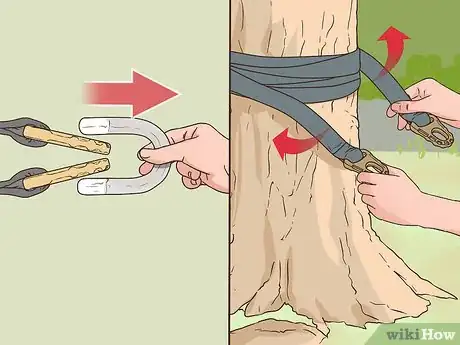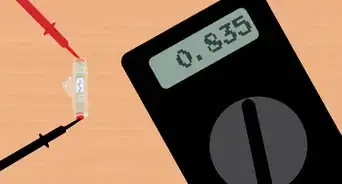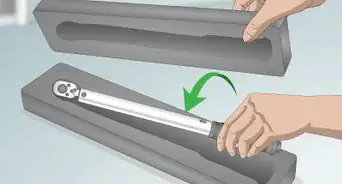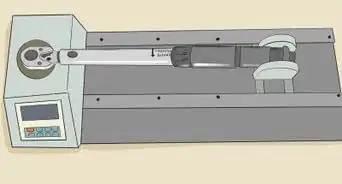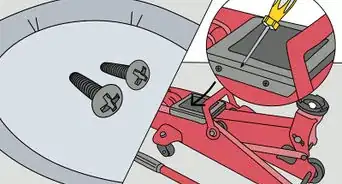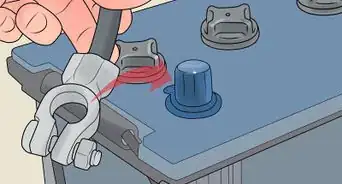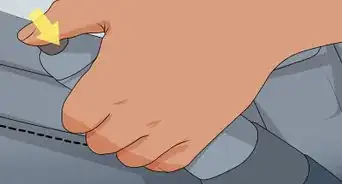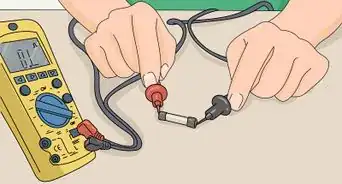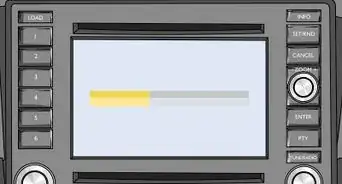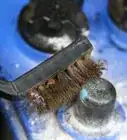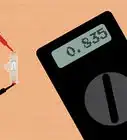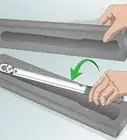This article was co-authored by wikiHow staff writer, Kyle Hall. Kyle Hall works on the content team at wikiHow. He helps manage our team of editors and creates content for a variety of wikiHow projects. Kyle continually looks for new ways to improve the content at wikiHow and make it more helpful and enjoyable for readers. He graduated from Eckerd College in 2015, where he majored in Political Science.
This article has been viewed 51,455 times.
Learn more...
Off-road driving with your vehicle can be exhilarating, but sometimes you might find yourself stuck on some rocks or in a pit of mud. Fortunately, if you have a winch mounted on your vehicle, you shouldn’t have any problem getting yourself unstuck. To use your winch properly, you’ll need to locate a sturdy anchor to attach it to. Once your winch is rigged, you can slowly pull your vehicle out from whatever it’s stuck in.
Steps
Rigging the Winch
-
1Plug the winch remote control into the winch. Your winch should have come with a remote control attached to a long cord. Look for the plug at the end of the cord and attach it to the corresponding receptacle on the outside of the winch. Run the remote control cord from the winch to the driver’s seat and place the remote control in your vehicle.[1]
-
2Put on a pair of thick gloves. Never handle a winch cable without gloves on. The cable could cut your hands.[2]Advertisement
-
3Find something in front of your car to anchor your winch to. A large tree trunk, boulder, or other vehicle is ideal. Don’t anchor your winch to something small and weak or you risk breaking it. Try to find an anchor that’s straight in front of your vehicle.[3]
-
4Use the disengage lever to release the winch cable. The disengage lever should be located on the outside of the winch. The lever should have an option that says “free spool” or “disengaged.” Turn the lever to that option. This will release the cable so you’re able to manually pull it out from the winch.[4]
-
5Pull the winch cable all the way to the anchor. Don't pull too much of the cable out or you'll create unnecessary slack. Set the end of the cable down next to the anchor.[5]
- If the winch cable doesn't reach the anchor, look for another anchor that's closer to your vehicle.
-
6Wrap a tree trunk protector around the bottom of the anchor. A tree trunk protector is a thick nylon strap with two loops, one on each end. Wrap the protector around the anchor so the two end loops are facing you. Hold the two end loops in your hand.[6]
- If your winch didn’t come with a tree trunk protector, you can order one online or find one at your local hardware store.
-
7Hook a D-shackle through the 2 loops on the protector. A D-shackle is a curved shackle with a large pin that screws in and out of the shackle. Remove the pin from the D-shackle and put the curved part of the D-shackle through both of the loops on the tree trunk protector. Once the loops are on the shackle, reinsert the pin and twist it to tighten it into place.[7]
-
8Hook the winch hook to the D-shackle with the tip facing up. The winch hook is the hook at the end of the winch cable.[8]
-
9Turn the disengage lever back to “engaged.” You want the lever to be back in the position it started in before you released the winch cable. This will prevent more cable from coming out of the winch.[9]
-
10Use the winch remote to slowly pull the winch cable taut. Press the button on the remote control to start pulling the winch cable back into the winch. This will cause the winch cable to tighten. Stop pressing the button when the cable is taut.[10]
Pulling Your Vehicle Out
-
1Make sure everyone’s cleared the area. It’s important that no one is standing behind or in front of your vehicle. No one should be standing near the winch cable. Always double check before you start pulling with the winch. People could be seriously injured if they’re in the way.[11]
-
2Get in the driver’s seat of your vehicle. Grab the winch remote control from the front seat and hold it in your hand. Remain in the vehicle the whole time you’re using the winch.[12]
-
3Winch the vehicle slowly using the remote control. Don’t try to pull your vehicle out quickly. You want to work slow and steady. Press the button on the remote control to start pulling your car out. You should feel your vehicle moving forward as it's pulled out from whatever it’s stuck in. Release the button every few seconds and then resume winching; this will keep you from going too fast.[13]
- While you’re pulling your vehicle out with the winch, gently press the gas pedal to help move your vehicle forward.
-
4Stop winching once your vehicle is on stable ground. You’ll know you’re on stable ground once your vehicle is flat and you’re able to drive it forward without the help of the winch. With your finger off the winch remote control button, gently press the gas pedal to see if you're able to drive forward.
Unrigging the Winch
-
1Unhook the winch cable from the D-shackle. Leave the D-shackle hooked to the tree trunk protector for now. You'll come back and get those after you take care of the winch cable.
-
2Use the remote control to slowly rewind the winch cable. Hold the end of the winch cable in your hand and walk it back in toward the winch as you’re rewinding the cable. Don’t let the winch cable slide through your hands as you’re rewinding it.[14]
-
3Unplug the winch remote control from the winch. Wrap up the cord attached to the remote control. Store the remote control in a dry place in your vehicle.[15]
-
4Retrieve the D-shackle and tree trunk protector from the anchor. Remove the pin from the D-shackle and slide the shackle off the loops on the protector. Reinsert the pin in the D-shackle so you don’t lose it. Store the D-shackle and tree trunk protector in your vehicle.[16]
Warnings
- Always survey your surroundings before using a winch to pull out your vehicle. Make sure there are no obstacles between your vehicle and the anchor that could interfere with the winch cable.⧼thumbs_response⧽
- Never operate a winch unless you’re certain there are no bystanders near the winch cable or behind your vehicle.[18]⧼thumbs_response⧽
Things You’ll Need
- Winch
- Vehicle
- Winch remote control
- Thick gloves
- Tree trunk protector
- D-shackle
References
- ↑ http://www.therangerstation.com/tech_library/pdf_documents/winchtech.pdf
- ↑ http://www.outdoorlife.com/blogs/article/atv-tips-5-things-you-should-never-do-when-using-winch
- ↑ http://www.therangerstation.com/tech_library/pdf_documents/winchtech.pdf
- ↑ http://www.therangerstation.com/tech_library/pdf_documents/winchtech.pdf
- ↑ http://www.therangerstation.com/tech_library/pdf_documents/winchtech.pdf
- ↑ http://www.fourwheeler.com/how-to/body-chassis/1611-winching-dos-and-donts-tips-tricks-for-safe-4x4-recovery/
- ↑ http://www.fourwheeler.com/how-to/body-chassis/1611-winching-dos-and-donts-tips-tricks-for-safe-4x4-recovery/
- ↑ http://www.therangerstation.com/tech_library/pdf_documents/winchtech.pdf
- ↑ http://www.therangerstation.com/tech_library/pdf_documents/winchtech.pdf
- ↑ http://www.therangerstation.com/tech_library/pdf_documents/winchtech.pdf
- ↑ http://www.fourwheeler.com/how-to/body-chassis/1611-winching-dos-and-donts-tips-tricks-for-safe-4x4-recovery/
- ↑ http://www.therangerstation.com/tech_library/pdf_documents/winchtech.pdf
- ↑ http://www.therangerstation.com/tech_library/pdf_documents/winchtech.pdf
- ↑ http://www.therangerstation.com/tech_library/pdf_documents/winchtech.pdf
- ↑ http://www.therangerstation.com/tech_library/pdf_documents/winchtech.pdf
- ↑ http://www.therangerstation.com/tech_library/pdf_documents/winchtech.pdf
- ↑ http://www.fourwheeler.com/how-to/body-chassis/1611-winching-dos-and-donts-tips-tricks-for-safe-4x4-recovery/
- ↑ http://www.therangerstation.com/tech_library/pdf_documents/winchtech.pdf
